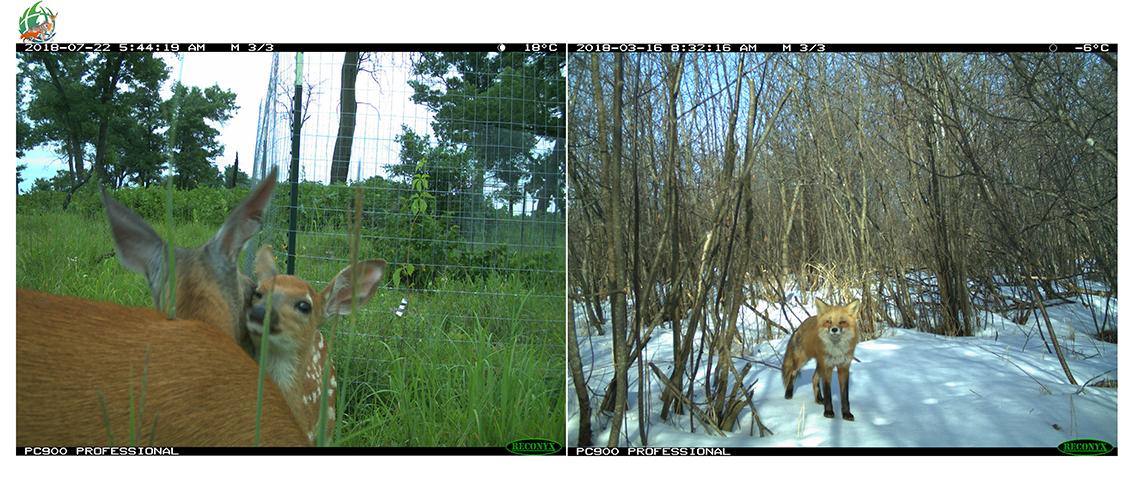
The Cedar Creek Ecosystem Science Reserve (CCESR) is a biological field station run by the College of Biological Sciences at the University of Minnesota. It includes diverse natural habitats that represent the entire state of Minnesota. Researchers use it for studies of different ecosystems and how humans are changing them. The CCESR Associate Director, Dr. Forest Isbell, is an MSI PI, and several other MSI PIs perform research there.
CCESR has been studying plant life in Minnesota ecosystems for many decades. In December 2018, they launched a citizen-science project aimed at identifying animals living in the reserve. The project, called Eyes on the Wild, involves the use of over 100 motion-sensitive cameras across the property to take pictures of all the types of wildlife that live there. These photos are uploaded to the Zooniverse citizen-science platform, where anyone from anywhere in the world can log in and help identify the animals. The information gathered here will help Cedar Creek researchers understand more about how the inhabitants interact with each other and the landscape.
The researchers are especially interested in wolves, which have been returning to the reserve. The disappearance of large predators has a serious effect on ecosystems worldwide, and it is unclear what effect the return of those predators will have on other wildlife, vegetation, soil nutrients, and more at Cedar Creek. Part of the Eyes on the Wild project requests that users identify wild canids including foxes, coyotes, and wolves. When enough photos are identified that way, a new task will allow users to pick out details that differentiate these different kinds of canids.
MSI is providing image-processing support as well as data storage for the huge numbers of images being generated - upwards of 1 million images annually. This project builds on the success and expertise of two other MSI-supported citizen-science projects developed by the University of Minnesota’s Lion Center, headed by MSI PI Craig Packer (professor, Ecology, Evolution, and Behavior), who is also collaborating on the Eyes on the Wild project at Cedar Creek. These previous projects, Snapshot Safari and Snapshot Serengeti, have also been featured on the MSI website:
Research on predator-prey interactions gathered from Snapshot Safari was the topic of one of the Finalist posters at the 2018 MSI Research Exhibition. The lead author, Meredith Palmer, helped establish the Eyes on the Wild project at Cedar Creek and is now a post-doctoral researcher at Princeton University. Other collaborators on this project include Dr. Caitlin Barale Potter (education and community engagement coordinator at Cedar Creek) and Dr. L. David Mech (senior scientist, USGS).
The Eyes on the Wild project has received media coverage throughout the Twin Cities:
- Minnesota Public Radio: Coyote? Weasel? University of Minnesota Researchers Seek Help Identifying Wildlife Photos
- Minneapolis StarTribune: Armchair Naturalists Help Minnesota Researchers Classify More Than 1 Million Nature Photos
- KSTP TV: Track Animals on Your Phone or Computer and Help With Research at the Cedar Creek Ecosystem Science Reserve
- Minnesota Daily: UMN Researchers Use Photos to Better Understand MN Ecosystem
Funding for this project was provided by the Minnesota Environment and Natural Resources Trust Fund as recommended by the Legislative‐Citizen Commission on Minnesota Resources (LCCMR). The Trust Fund is a permanent fund constitutionally established by the citizens of Minnesota to assist in the protection, conservation, preservation, and enhancement of the state’s air, water, land, fish, wildlife, and other natural resources. Currently 40% of net Minnesota State Lottery proceeds are dedicated to growing the Trust Fund and ensuring future benefits for Minnesota’s environment and natural resources.
Image description: Photos from camera traps around the Cedar Creek Ecosystem Science Reserve. Left: Doe and fawn. Right: Red fox.
posted on February 15, 2019